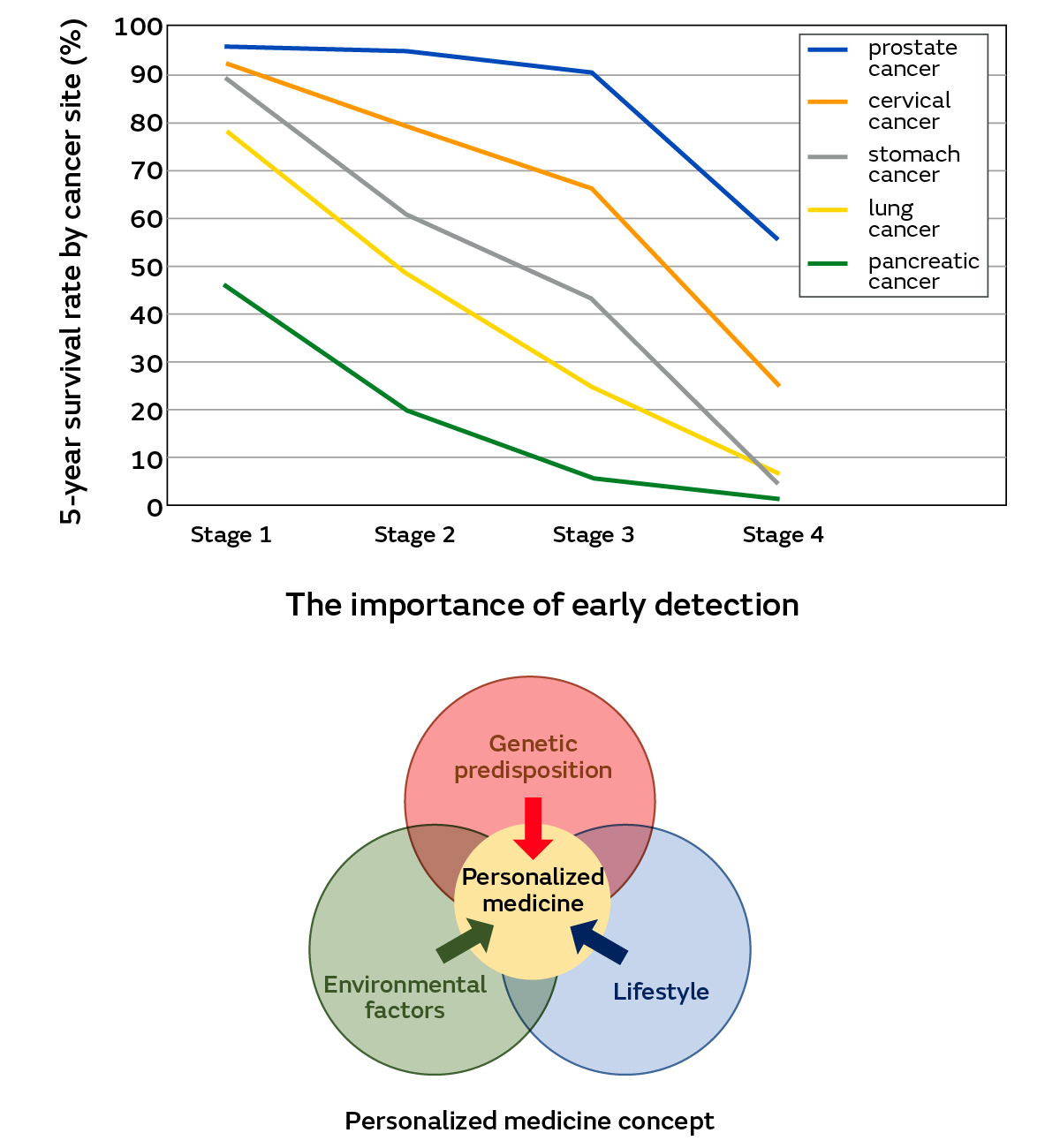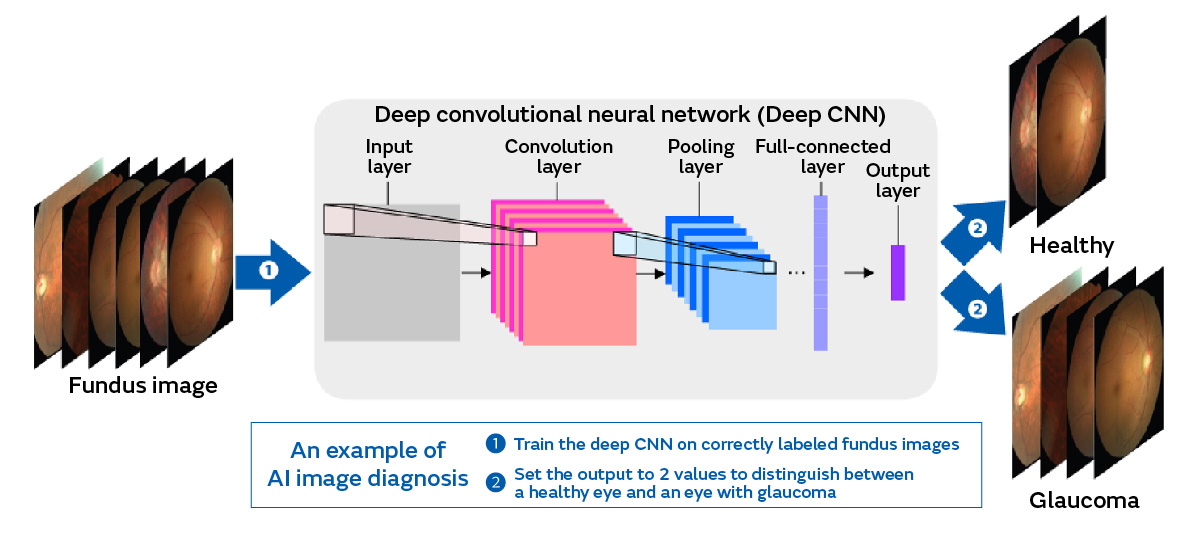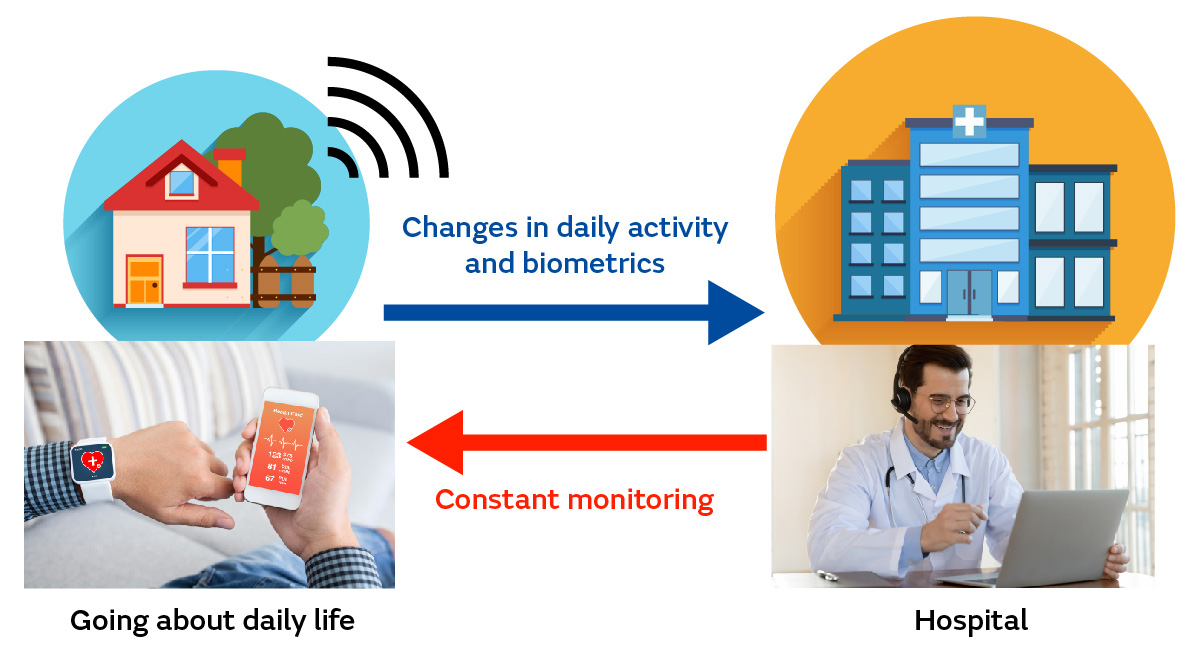Electronic Technology Supporting the Evolution of “Next Tech”
MedTech Provides Optimal Medical Treatment and Care Tailored to Each and Every One of Us
Among recent advances in science, it is perhaps those in life sciences that are the most remarkable. In the medical field, new technologies such as genetic analysis, AI, and IoT/wearables are emerging all the time. We are on the cusp of a turning point in history, where approaches to curing illnesses and maintaining health seem set to be completely transformed. In this article, we're going to look at “MedTech,” a movement of medical technology reform that utilizes advanced life science technologies and ICT to drive these developments (Fig. 1).

Medtech is gaining attention as an enabler for early diagnosis/treatment and personalized medicine
“MedTech” is a neologism formed by combining the words “medical” and “technology.” It refers to the proactive adoption of various technologies from various sectors to aid in diagnosis and treatment, with the aim of achieving more effective and efficient prevention, testing, diagnosis, and treatment of diseases, as well as rehabilitation.
Generally speaking, medical treatment up until now has been carried out when someone who is already feeling unwell visits a hospital. The patient is examined, the illness they are suffering from is identified, and is treated with reference to past cases. Of course, illnesses can also be discovered during regular health checkups, but in most cases, treatment begins after the illness has already developed.
However, there are certain limitations associated with this established practice. It would be better to deal with an illness promptly before it becomes aggravated, thus making the treatment simpler and the healing quicker. Early diagnosis and treatment are especially important with serious illnesses such as cancer, where time is a factor that can mean the difference between life and death (Fig. 2). However, tests that might be taken during a physical examination, such as blood tests and X-rays, are only able to detect a condition after it has progressed to some extent. What's more, even in developed countries, only about 40% of people undergo cancer screening. This inability to detect illnesses early on also has some serious social ramifications. The more a disease progresses, the more the medical costs associated with treating it tend to rise, which, in countries where the population is aging, puts pressure on public finances.

Conventional medical care has also faced challenges in diagnoses and treatment methods. Even when patients have the same illness – affecting the same area with the same degree of symptoms – and receive the same treatment, the prognosis can vary significantly depending on the patient. This is due to additional factors about each patient that are different, such as their physical constitution and strength, lifestyle, and genetic factors, and even things like their place of abode, economic situation, occupation, and environmental factors. To make the best diagnosis and offer the best treatment, it is necessary to understand these individual differences in patients and optimize the treatment and medication for each individual. However, until now, there was no way to easily and accurately gauge individual differences, so the best treatment could not always be administered.
The rise of genetic analysis
MedTech is garnering attention as a means of not only aiding early detection and early diagnosis of diseases, but also tailoring diagnosis and treatment in consideration of individual differences between patients, something not previously possible. Let's look at how the use of genetic analysis, AI, and IoT is facilitating this progress in medical care.
Entering the 21st century, it has become simple to examine the differences between gene sequences, the blueprints of each person's body, and understand how they affect things like physical make-up, personality, and predisposition to disease. If you undergo genetic analysis once during your lifetime, you will find out your risk of getting illnesses such as cancer, diabetes, stroke, and high blood pressure. It will even tell you things such as how well your body can handle alcohol. Knowing your own genetic information can help to inform lifestyle changes that reduce the likelihood of getting an illness you are at high risk for.
Many people assume genetic analysis needs to be carried out at a laboratory with specialist equipment. Actually, the cost of gene sequence analysis has continued to decrease rapidly at a pace that outstrips the forecast of “Moore's Law,” which predicts the exponential evolution and cost of semiconductors, and now costs only around 10,000 yen, and there are commercial services available that can examine upwards of 300 components related to your physical make-up and risk of diseases from a simple saliva sample (Fig. 3). Databases of genetic information and improved ICT processing capabilities such as AI have supported this rapid progress.

A technology called “liquid biopsy” is also steadily moving toward the stage where it can be put into practical use. A liquid biopsy employs genetic analysis technology and can discover disease at a very early stage before it proliferates from a single drop of blood or urine. If liquid biopsies are added to the tests performed on a blood sample during a six-monthly health checkup, it would become possible not only to catch cancer before it becomes a tumor, but also to pinpoint the location of the cancer and the extent of its progression. In addition to cancer, liquid biopsies can be used in the early diagnosis and treatment of illnesses such as arteriosclerosis, nervous disorders such as Alzheimer's and Parkinson's, and infectious diseases. Development is currently underway to make liquid biopsies available not only in large hospitals, but also in local clinics. The key to such technological development is the downsizing of equipment. This is where the miniaturization techniques developed in the electronics sector, such as the miniaturization of analytical elements, will be put to good use.
Delivering advanced medical care to every corner of the world with AI
Meanwhile, efforts are also underway to imbue AI with the knowledge and skills of experienced doctors, so that advanced medical care can be offered to a wider range of people in a more meticulous manner. AI systems have now become able to pick up on slight abnormalities in X-ray photos, ultrasound images or fundus photos that even a veteran doctor might miss, as well as detect signs of a hidden illness based on slight changes in things like pulse and body temperature from day to day (Fig. 4).

Countries with aging populations are increasing around the world. Despite the annually increasing need for medical care that this entails, the number of young medical workers is insufficient. This is especially true in underpopulated areas, where specialist doctors are in short supply and a single doctor might be expected to be in charge of a wide range of clinical departments. This puts doctors at a disadvantage because they are too busy to learn and become proficient in new medical techniques.
In situations like this, AI can help to ease the burden. As long as an internet connection is available, specialist medical care can be delivered from anywhere in the world to anywhere else in the world. To develop medical AI capable of making highly accurate diagnoses and judgments, it needs to be trained on even more image data. To that end, efforts are being made to create a database of high-quality, diverse image data collected from multiple hospitals.
Wearables give doctors insight into your daily life
In recent years, wearable devices such as smartwatches have emerged and become widespread, with many people now wearing them on a daily basis. Smartwatches and other wearables are equipped with various sensors such as activity trackers and heart rate monitors. These sensors have made it possible to track in real time a person's lifestyle, sleep, physical condition, and other vitals even outside of a hospital setting.
All diseases are caused by a complex combination of factors related to genes, environment, and lifestyle. Being aware of daily changes in activity and biometric data reveals environmental factors, making it possible to combat lifestyle-related illnesses, provide meticulous care for chronic diseases, and personalize medicine.
There are already smartwatches available that are able to produce the same types of readings as those taken at hospital, such as an electrocardiogram and blood oxygen concentration in the body. Of course, these readings are less accurate than those taken on medical equipment at a hospital; however, smartwatches have an advantage in the fact that they are able to constantly record changes in biometrics from day to day. Even the most accurate testing at a hospital cannot detect abnormalities that are specific to a particular time, activity, or place as you go about your daily life, or that are sudden and unexpected. With a wearable device, such abnormalities that would be missed by hospital equipment can be discovered. What's more, as most wearables are always connected to the internet, doctors at the hospital can also keep an eye on things (Fig. 5). As semiconductors, batteries, and other electronic components continue to get smaller and more sophisticated, wearable devices will surely become able to more easily acquire a greater range of biometric data.

Various other technologies also come under the umbrella term of “MedTech,” such as precision surgery using surgical robots, and remote medical care carried out via video conferencing software. With innovations like these, medical care seems set to be completely transformed in the near future.
- Continue reading:“Agri-Tech” Brings Out the Potential of Land and Crops

